Lexus LC Cabriolet (2021 year). Manual in english — page 10

220
4-4. Refueling
the fuel filler door cannot be opened.
2
Turn the fuel tank cap slowly and
remove it, then put it into the holder
on the fuel filler door.
Q
If the fuel filler door cannot be opened
P.403
After refueling, turn the fuel tank cap
until you hear a click. Once the cap is
released, it will turn slightly in the
opposite direction.
Closing the fuel tank cap
WARNING
Q
When replacing the fuel tank cap
Do not use anything but a genuine Lexus
fuel tank cap designed for your vehicle.
Doing so may cause a fire or other inci-
dent which may result in death or serious
injury.
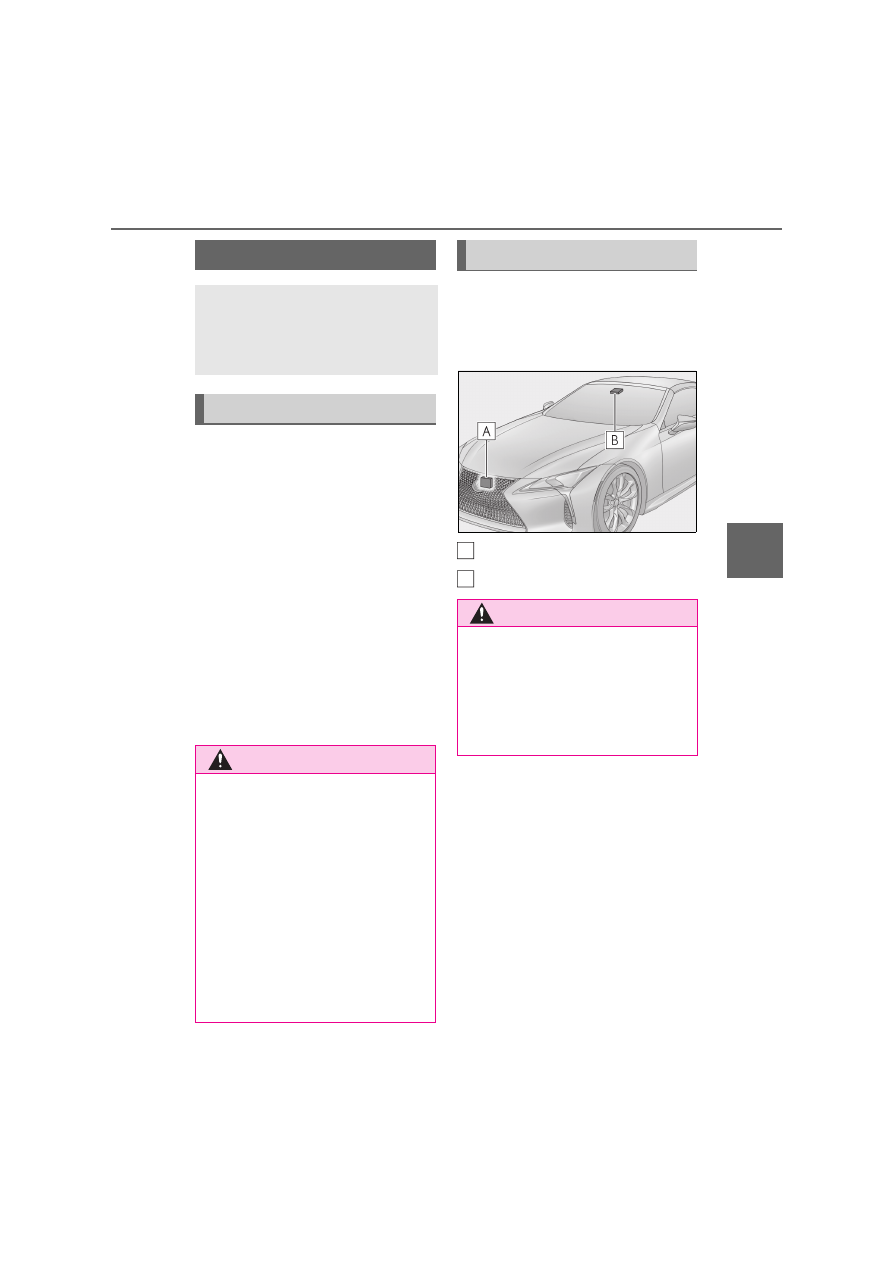
221
4
4-5. Using the driving support systems
Dr
ivin
g
4-5.Using the driving support systems
Q
PCS (Pre-Collision System)
P.232
Q
LKA (Lane-Keeping Assist)
P.240
Q
Automatic High Beam
P.211
Q
RSA (Road Sign Assist)
*
P.248
Q
Dynamic radar cruise control with
full-speed range
P.252
*
: If equipped
Two types of sensors, located behind
the front grille and windshield, detect
information necessary to operate the
drive assist systems.
Radar sensor
Front camera
Lexus Safety System +
The Lexus Safety System + consists
of the following drive assist systems
and contributes to a safe and com-
fortable driving experience:
Driving assist system
WARNING
Q
Lexus Safety System +
The Lexus Safety System + is designed to
operate under the assumption that the
driver will drive safely, and is designed to
help reduce the impact to the occupants
and the vehicle in the case of a collision
or assist the driver in normal driving con-
ditions.
As there is a limit to the degree of recog-
nition accuracy and control performance
that this system can provide, do not
overly rely on this system. The driver is
always responsible for paying attention
to the vehicle’s surroundings and driving
safely.
Sensors
WARNING
Q
To avoid malfunction of the radar sen-
sor
Observe the following precautions.
Otherwise, the radar sensor may not
operate properly, possibly leading to an
accident resulting in death or serious
injury.
A
B

222
4-5. Using the driving support systems
WARNING
O
Keep the radar sensor and the radar
sensor cover clean at all times.
Radar sensor
Radar sensor cover
If the front of the radar sensor or the front
or back of the radar sensor cover is dirty
or covered with water droplets, snow,
etc., clean it.
Clean the radar sensor and radar sensor
cover with a soft cloth to avoid damaging
them.
O
Do not attach accessories, stickers
(including transparent stickers) or
other items to the radar sensor, radar
sensor cover or surrounding area.
O
Do not subject the radar sensor or its
surrounding area to a strong impact.
If the radar sensor, front grille, or front
bumper has been subjected to a
strong impact, have the vehicle
inspected by any authorized Lexus
retailer or Lexus authorized repairer,
or any reliable repairer.
O
Do not disassemble the radar sensor.
O
Do not modify or paint the radar sen-
sor or radar sensor cover.
A
B
O
In the following cases, the radar sensor
must be recalibrated. Contact any
authorized Lexus retailer or Lexus
authorized repairer, or any reliable
repairer for details.
• When the radar sensor or front grille
are removed and installed, or replaced
• When the front bumper is replaced
Q
To avoid malfunction of the front
camera
Observe the following precautions.
Otherwise, the front camera may not
operate properly, possibly leading to an
accident resulting in death or serious
injury.
O
Keep the windshield clean at all times.
• If the windshield is dirty or covered
with an oily film, water droplets, snow,
etc., clean the windshield.
• If a glass coating agent is applied to the
windshield, it will still be necessary to
use the windshield wipers to remove
water droplets, etc. from the area of
the windshield in front of the front
camera.
• If the inner side of the windshield
where the front camera is installed is
dirty, contact any authorized Lexus
retailer or Lexus authorized repairer,
or any reliable repairer.
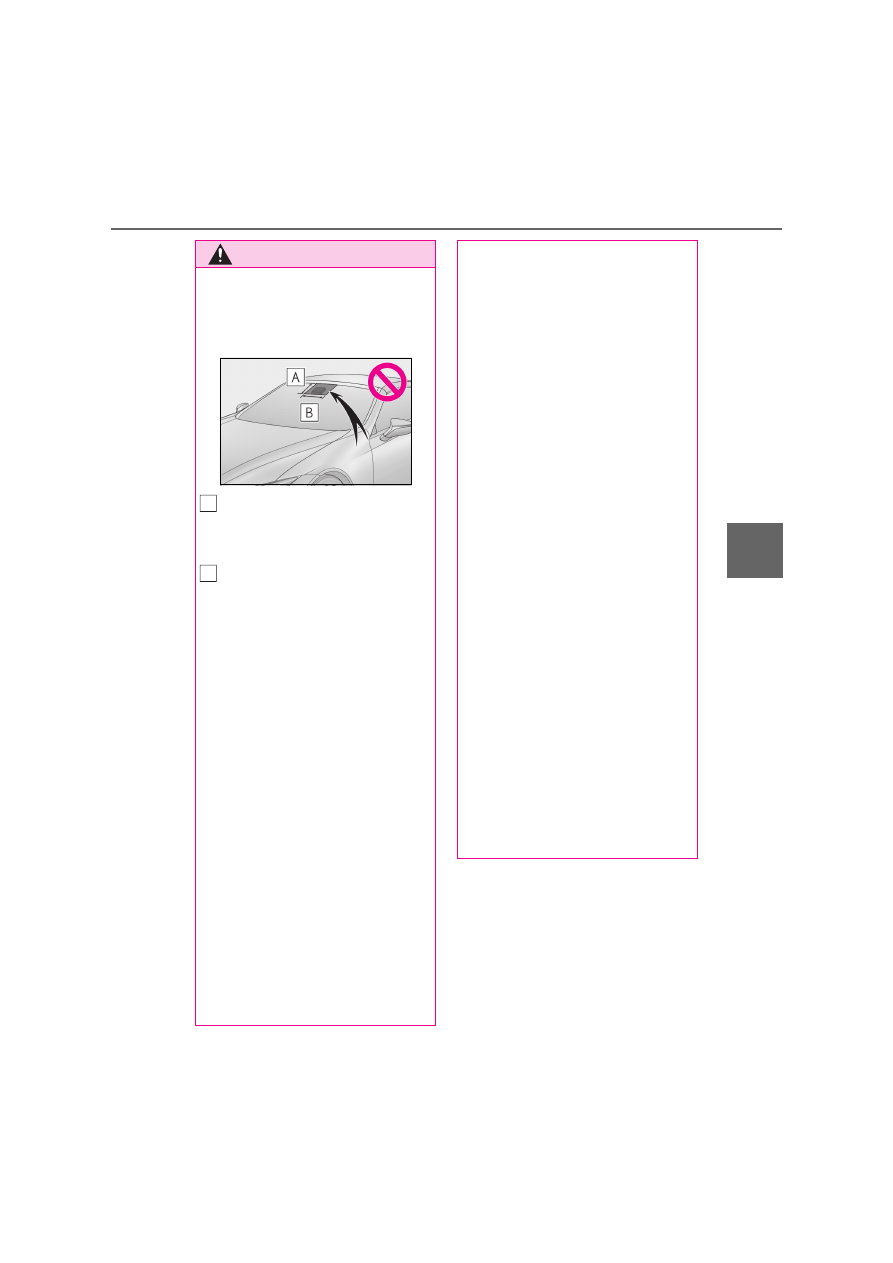
223
4
4-5. Using the driving support systems
Dr
ivin
g
WARNING
O
Do not attach objects, such as stickers,
transparent stickers, etc., to the outer
side of the windshield in front of the
front camera (shaded area in the illus-
tration).
From the top of the windshield to
approximately 1 cm (0.4 in.) below
the bottom of the front camera
Approximately 20 cm (7.9 in.)
(Approximately 10 cm [4.0 in.] to the
right and left from the center of the
front camera)
O
If the part of the windshield in front of
the front camera is fogged up or cov-
ered with condensation, or ice, use the
windshield defogger to remove the
fog, condensation, or ice. (
P.307)
O
If water droplets cannot be properly
removed from the area of the wind-
shield in front of the front camera by
the windshield wipers, replace the
wiper insert or wiper blade.
O
Do not attach window tint to the wind-
shield.
O
Replace the windshield if it is damaged
or cracked.
After replacing the windshield, the
front camera must be recalibrated.
Contact any authorized Lexus retailer
or Lexus authorized repairer, or any
reliable repairer for details.
O
Do not allow liquids to contact the
front camera.
A
B
O
Do not allow bright lights to shine into
the front camera.
O
Do not dirty or damage the front cam-
era.
When cleaning the inside of the wind-
shield, do not allow glass cleaner to
contact the lens of the front camera.
Also, do not touch the lens.
If the lens is dirty or damaged, contact
any authorized Lexus retailer or Lexus
authorized repairer, or any reliable
repairer.
O
Do not subject the front camera to a
strong impact.
O
Do not change the installation position
or direction of the front camera or
remove it.
O
Do not disassemble the front camera.
O
Do not modify any components of the
vehicle around the front camera
(inside rear view mirror, etc.) or ceil-
ing.
O
Do not attach any accessories to the
hood, front grille or front bumper that
may obstruct the front camera. Con-
tact any authorized Lexus retailer or
Lexus authorized repairer, or any reli-
able repairer for details.
O
If a surfboard or other long object is to
be mounted on the roof, make sure
that it will not obstruct the front cam-
era.
O
Do not modify the headlights or other
lights.
231
4
4-5. Using the driving support systems
Dr
ivin
g
O
In the following situations, if the situation has changed (or the vehicle has been driven for
some time) and the normal operating conditions are detected, the message will disap-
pear and the system will become operational.
If the message does not disappear, contact any authorized Lexus retailer or Lexus autho-
rized repairer, or any reliable repairer.
• When the temperature around the radar sensor is outside of the operational range, such
as when the vehicle is in the sun or in an extremely cold environment
• When the front camera cannot detect objects in front of the vehicle, such as when driving
in the dark, snow, or fog, or when bright lights are shining into the front camera
Situation
Actions
When the area around a sensor is covered
with dirt, moisture (fogged up, covered with
condensation, ice, etc.), or other foreign
matter
To clean the part of the windshield in front of
the front camera, use the windshield wipers
or the windshield defogger of the air condi-
tioning system (
P.307).
When the temperature around the front
camera is outside of the operational range,
such as when the vehicle is in the sun or in an
extremely cold environment
If the front camera is hot, such as after the
vehicle had been parked in the sun, use the
air conditioning system to decrease the tem-
perature around the front camera.
If a sunshade was used when the vehicle was
parked, depending on its type, the sunlight
reflected from the surface of the sunshade
may cause the temperature of the front cam-
era to become excessively high.
If the front camera is cold, such after the
vehicle is parked in an extremely cold envi-
ronment, use the air conditioning system to
increase the temperature around the front
camera.
The area in front of the front camera is
obstructed, such as when the hood is open
or a sticker is attached to the part of the
windshield in front of the front camera.
Close the hood, remove the sticker, etc. to
clear the obstruction.

232
4-5. Using the driving support systems
The countries and areas for each region listed in the table are current as of June
2020. However, depending on when the vehicle was sold, the countries and areas
of each region may be different. Contact your Lexus dealer for details.
Q
Pre-collision warning
When the system determines that the
possibility of a frontal collision is high, a
buzzer will sound and a warning mes-
sage will be displayed on the multi-
information display to urge the driver
to take evasive action.
PCS (Pre-Collision System)
The pre-collision system uses a radar sensor and front camera to detect vehi-
cles and pedestrians
*1
in front of your vehicle. When the system determines
that the possibility of a frontal collision with a vehicle or pedestrian is high, a
warning operates to urge the driver to take evasive action and the potential
brake pressure is increased to help the driver avoid the collision. If the system
determines that the possibility of a frontal collision with a vehicle or pedestrian
is extremely high, the brakes are automatically applied to help avoid the colli-
sion or help reduce the impact of the collision.
The pre-collision system can be disabled/enabled and the warning timing can be
changed. (
P.234)
*1
: Depending on the region in which the vehicle was sold, the pedestrian detection
function may not be available. See the following table for details.
Detectable objects
Countries/areas
Function availability
Regions
Iceland, Ireland, United Kingdom, Italy, Ukraine,
Estonia, Austria, Netherlands, Cyprus, Greece,
Switzerland, Sweden, Spain, Slovakia, Slovenia,
Czech Republic, Germany, Norway, Hungary, Fin-
land, France, Bulgaria, Belgium, Poland, Portugal,
Latvia, Lithuania, Romania, Israel, Turkey, Canary
Islands
The pedestrian detection
function is available
Region A
Azerbaijan
The pedestrian detection
function is not available
Region B
System functions

233
4
4-5. Using the driving support systems
Dr
ivin
g
Q
Pre-collision brake assist
When the system determines that the
possibility of a frontal collision is high,
the system applies greater braking
force in relation to how strongly the
brake pedal is depressed.
Q
Pre-collision braking
When the system determines that the
possibility of a frontal collision is high,
the system warns the driver. If the sys-
tem determines that the possibility of a
frontal collision is extremely high, the
brakes are automatically applied to
help avoid the collision or reduce the
collision speed.
Q
Suspension control
When the system determines that the
possibility of a frontal collision is high,
the Adaptive Variable Suspension Sys-
tem (
P.291) will control the damping
force of the shock absorbers to help
maintain an appropriate vehicle pos-
ture.
WARNING
Q
Limitations of the pre-collision sys-
tem
O
The driver is solely responsible for safe
driving. Always drive safely, taking
care to observe your surroundings.
Do not use the pre-collision system
instead of normal braking operations
under any circumstances. This system
will not prevent collisions or lessen col-
lision damage or injury in every situa-
tion. Do not overly rely on this system.
Failure to do so may lead to an acci-
dent, resulting in death or serious
injury.
O
Although this system is designed to
help avoid a collision or help reduce
the impact of the collision, its effective-
ness may change according to various
conditions, therefore the system may
not always be able to achieve the same
level of performance.
Read the following conditions care-
fully. Do not overly rely on this system
and always drive carefully.
• Conditions under which the system
may operate even if there is no possi-
bility of a collision:
P.236
• Conditions under which the system
may not operate properly:
P.238
O
Do not attempt to test the operation of
the pre-collision system yourself.
Depending on the objects used for
testing (dummies, cardboard objects
imitating detectable objects, etc.), the
system may not operate properly, pos-
sibly leading to an accident.
Q
Pre-collision braking
O
When the pre-collision braking func-
tion is operating, a large amount of
braking force will be applied.
234
4-5. Using the driving support systems
Q
Enabling/disabling the pre-colli-
sion system
The pre-collision system can be
enabled/disabled on
(
P.93) of
the multi-information display.
The system is automatically enabled each
time the engine switch is turned to ON.
If the system is disabled, the PCS warn-
WARNING
O
If the vehicle is stopped by the opera-
tion of the pre-collision braking func-
tion, the pre-collision braking function
operation will be canceled after
approximately 2seconds. Depress the
brake pedal as necessary.
O
The pre-collision braking function may
not operate if certain operations are
performed by the driver. If the acceler-
ator pedal is being depressed strongly
or the steering wheel is being turned,
the system may determine that the
driver is taking evasive action and pos-
sibly prevent the pre-collision braking
function from operating.
O
In some situations, while the pre-colli-
sion braking function is operating,
operation of the function may be can-
celed if the accelerator pedal is
depressed strongly or the steering
wheel is turned and the system deter-
mines that the driver is taking evasive
action.
O
If the brake pedal is being depressed,
the system may determine that the
driver is taking evasive action and pos-
sibly delay the operation timing of the
pre-collision braking function.
Q
When to disable the pre-collision sys-
tem
In the following situations, disable the
system, as it may not operate properly,
possibly leading to an accident resulting
in death or serious injury:
O
When the vehicle is being towed
O
When your vehicle is towing another
vehicle
O
When transporting the vehicle via
truck, boat, train or similar means of
transportation
O
When the vehicle is raised on a lift with
the engine running and the tires are
allowed to rotate freely
O
When inspecting the vehicle using a
drum tester such as a chassis
dynamometer or speedometer tester,
or when using an on vehicle wheel bal-
ancer
O
When a strong impact is applied to the
front bumper or front grille, due to an
accident or other reasons
O
If the vehicle cannot be driven in a sta-
ble manner, such as when the vehicle
has been in an accident or is malfunc-
tioning
O
When the vehicle is driven in a sporty
manner or off-road
O
When the tires are not properly
inflated
O
When the tires are very worn
O
When tires of a size other than speci-
fied are installed
O
When tire chains are installed
O
When a compact spare tire or an
emergency tire puncture repair kit is
used
O
If equipment (snow plow, etc.) that
may obstruct the radar sensor or front
camera is temporarily installed to the
vehicle
Changing settings of the pre-
collision system
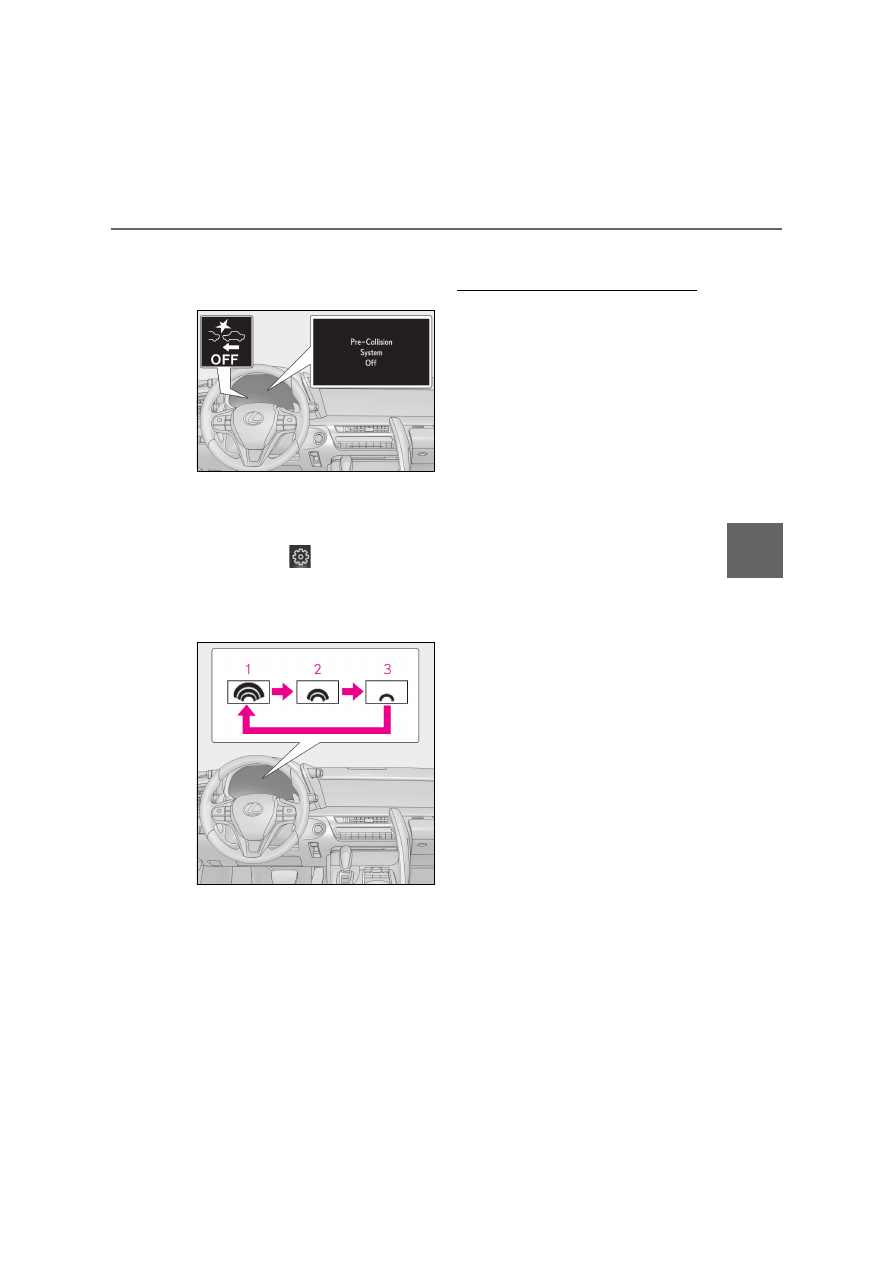
235
4
4-5. Using the driving support systems
Dr
ivin
g
ing light will turn on and a message will
be displayed on the multi-information
display.
Q
Changing the pre-collision warn-
ing timing
The pre-collision warning timing can
be changed on
(
P.93) of the
multi-information display.
The operation timing setting is retained
when the engine switch is turned off.
1
Far
The warning will begin to operate earlier
than with the default timing.
2
Middle
This is the default setting.
3
Near
The warning will begin to operate later
than with the default timing.
Q
Operational conditions
Availability of the pedestrian detection
function depends on the region in which the
vehicle was sold. (For specific coun-
tries/areas:
P.232)
Read the following for details:
Region A
(The pedestrian detection function is
available)
The pre-collision system is enabled and the
system determines that the possibility of a
frontal collision with a vehicle or pedestrian
is high.
Each function is operational at the following
speeds:
O
Pre-collision warning:
• Vehicle speed is between approximately
10 and 180 km/h (7 and 110 mph). (For
detecting a pedestrian, vehicle speed is
between approximately 10 and 80 km/h
[7 and 50 mph].)
• The relative speed between your vehicle
and the vehicle or pedestrian ahead is
approximately 10 km/h (7 mph) or more.
O
Pre-collision brake assist:
• Vehicle speed is between approximately
30 and 180 km/h (20 and 110 mph). (For
detecting a pedestrian, vehicle speed is
between approximately 30 and 80 km/h
[20 and 50 mph].)
• The relative speed between your vehicle
and the vehicle or pedestrian ahead is
approximately 30 km/h (20 mph) or
more.
O
Pre-collision braking:
• Vehicle speed is between approximately
10 and 180 km/h (7 and 110 mph). (For
detecting a pedestrian, vehicle speed is
between approximately 10 and 80 km/h
[7 and 50 mph].)
• The relative speed between your vehicle
and the vehicle or pedestrian ahead is
approximately 10 km/h (7 mph) or more.
The system may not operate in the following
situations:
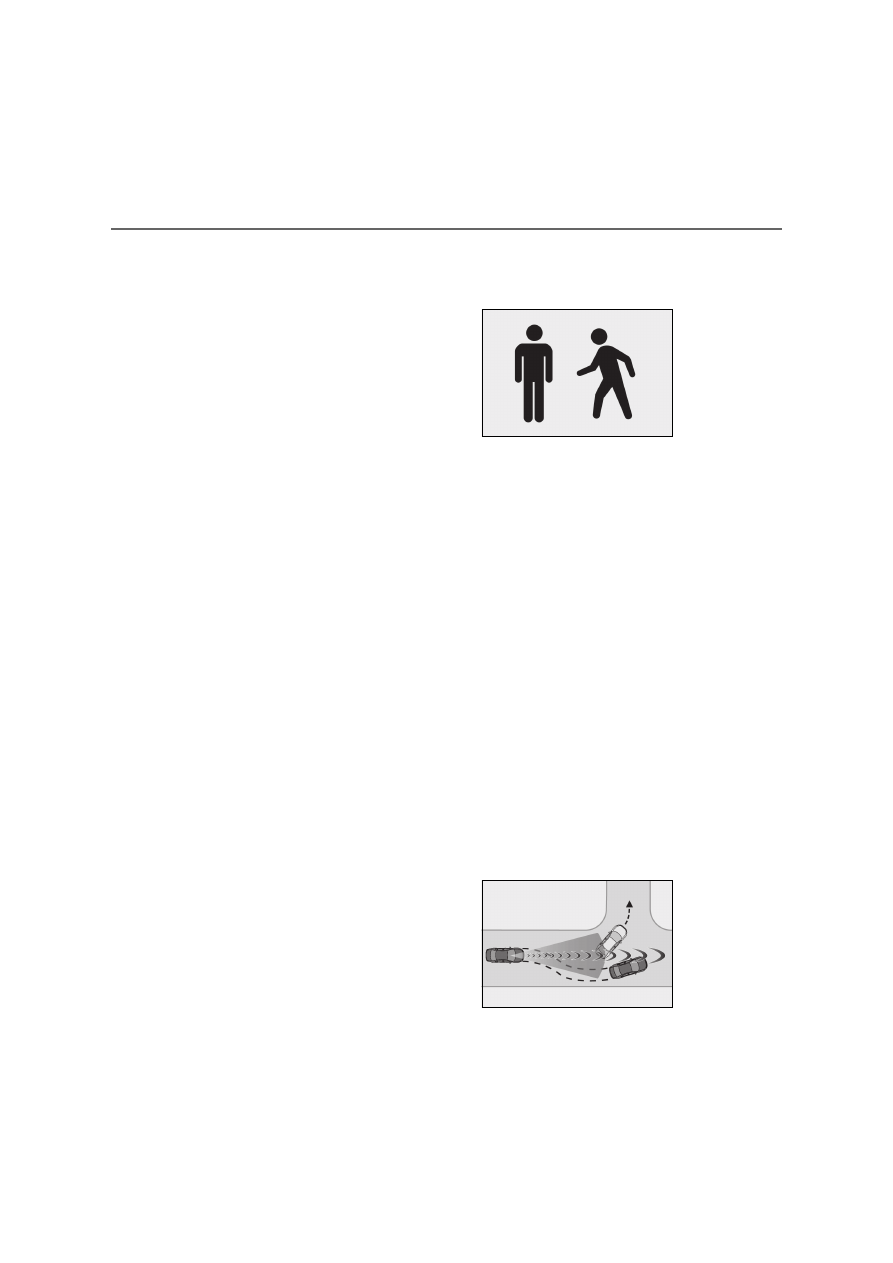
236
4-5. Using the driving support systems
O
If a battery terminal has been discon-
nected and reconnected and then the
vehicle has not been driven for a certain
amount of time
O
If the shift position is in R
O
If VSC is disabled (only the pre-collision
warning function will be operational)
Region B
(The pedestrian detection function is not
available)
The pre-collision system is enabled and the
system determines that the possibility of a
frontal collision with a vehicle is high.
Each function is operational at the following
speeds:
O
Pre-collision warning:
• Vehicle speed is between approximately
15 and 180 km/h (10 and 110 mph).
• The relative speed between your vehicle
and the vehicle ahead is approximately
10 km/h (7 mph) or more.
O
Pre-collision brake assist:
• Vehicle speed is between approximately
30 and 180 km/h (20 and 110 mph).
• The relative speed between your vehicle
and the vehicle ahead is approximately
30 km/h (20 mph) or more.
O
Pre-collision braking:
• Vehicle speed is between approximately
15 and 180 km/h (10 and 110 mph).
• The relative speed between your vehicle
and the vehicle ahead is approximately
10 km/h (7 mph) or more.
The system may not operate in the following
situations:
O
If a battery terminal has been discon-
nected and reconnected and then the
vehicle has not been driven for a certain
amount of time
O
If the shift position is in R
O
If VSC is disabled (only the pre-collision
warning function will be operational)
Q
Pedestrian detection function
*2
The pre-collision system detects pedestri-
ans based on the size, profile, and motion of
a detected object. However, a pedestrian
may not be detected depending on the sur-
rounding brightness and the motion, pos-
ture, and angle of the detected object,
preventing the system from operating
properly. (
P.238)
*2
: For countries/areas specified as Region
B (
P.232), the pedestrian detection
function may not be available.
Q
Cancelation of the pre-collision braking
If either of the following occur while the
pre-collision braking function is operating,
it will be canceled:
O
The accelerator pedal is depressed
strongly.
O
The steering wheel is turned sharply or
abruptly.
Q
Conditions under which the system may
operate even if there is no possibility of a
collision
O
In some situations such as the following,
the system may determine that there is a
possibility of a frontal collision and oper-
ate.
• When passing a vehicle or pedestrian
*2
• When changing lanes while overtaking a
preceding vehicle
• When overtaking a preceding vehicle
that is changing lanes
• When overtaking a preceding vehicle
that is making a left/right turn
• When passing a vehicle in an oncoming
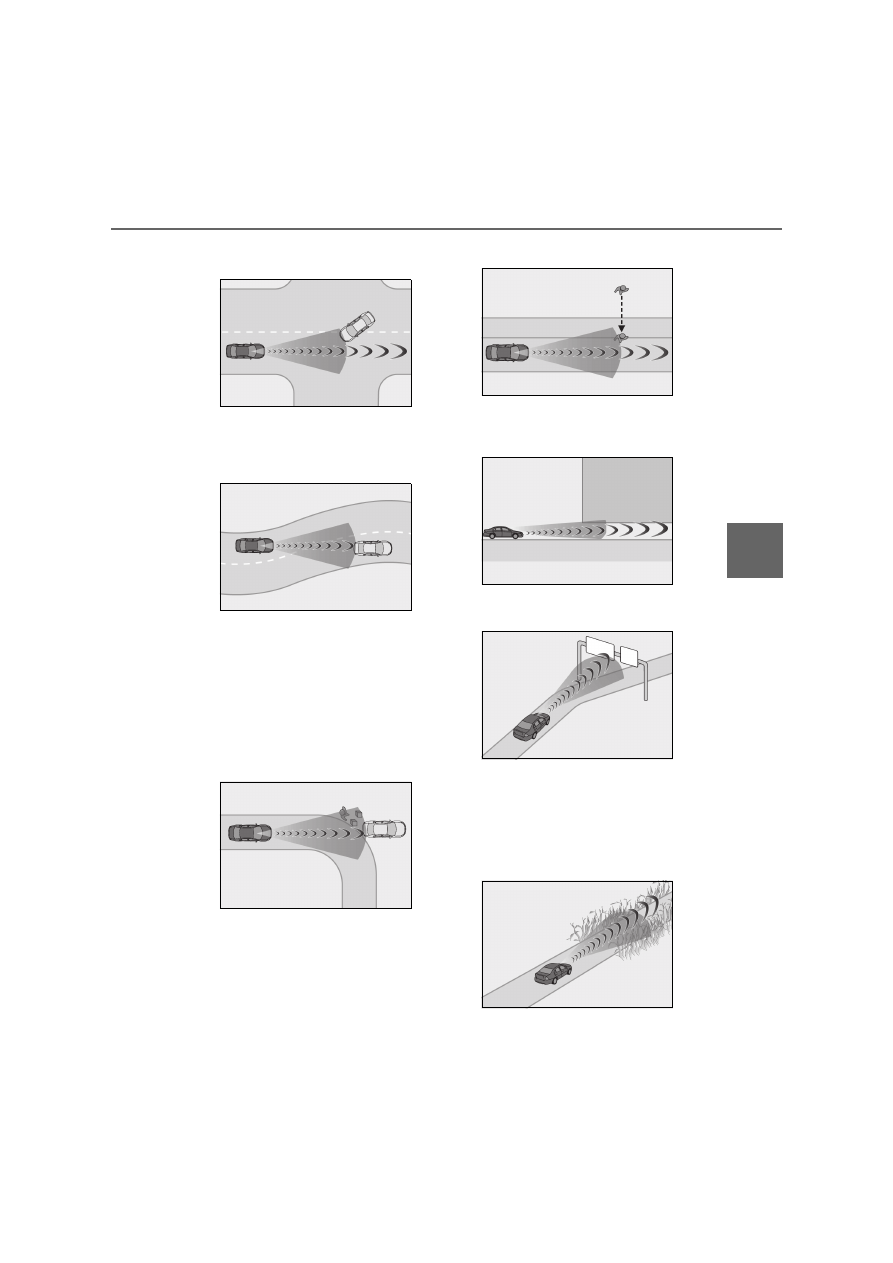
237
4
4-5. Using the driving support systems
Dr
ivin
g
lane that is stopped to make a right/left
turn
• When driving on a road where relative
location to vehicle ahead in an adjacent
lane may change, such as on a winding
road
• When rapidly closing on a vehicle ahead
• If the front of the vehicle is raised or low-
ered, such as when the road surface is
uneven or undulating
• When approaching objects on the road-
side, such as guardrails, utility poles,
trees, or walls
• When there is a vehicle, pedestrian
*2
, or
object by the roadside at the entrance of
a curve
• When driving on a narrow path sur-
rounded by a structure, such as in a tun-
nel or on an iron bridge
• When there is a metal object (manhole
cover, steel plate, etc.), steps, or a protru-
sion on the road surface or roadside
• When a crossing pedestrian approaches
very close to the vehicle
*2
• When passing through a place with a low
structure above the road (low ceiling,
traffic sign, etc.)
• When passing under an object (billboard,
etc.) at the top of an uphill road
• When rapidly closing on an electric toll
gate barrier, parking area barrier, or
other barrier that opens and closes
• When using an automatic car wash
• When driving through or under objects
that may contact the vehicle, such as
thick grass, tree branches, or a banner
• When the vehicle is hit by water, snow,
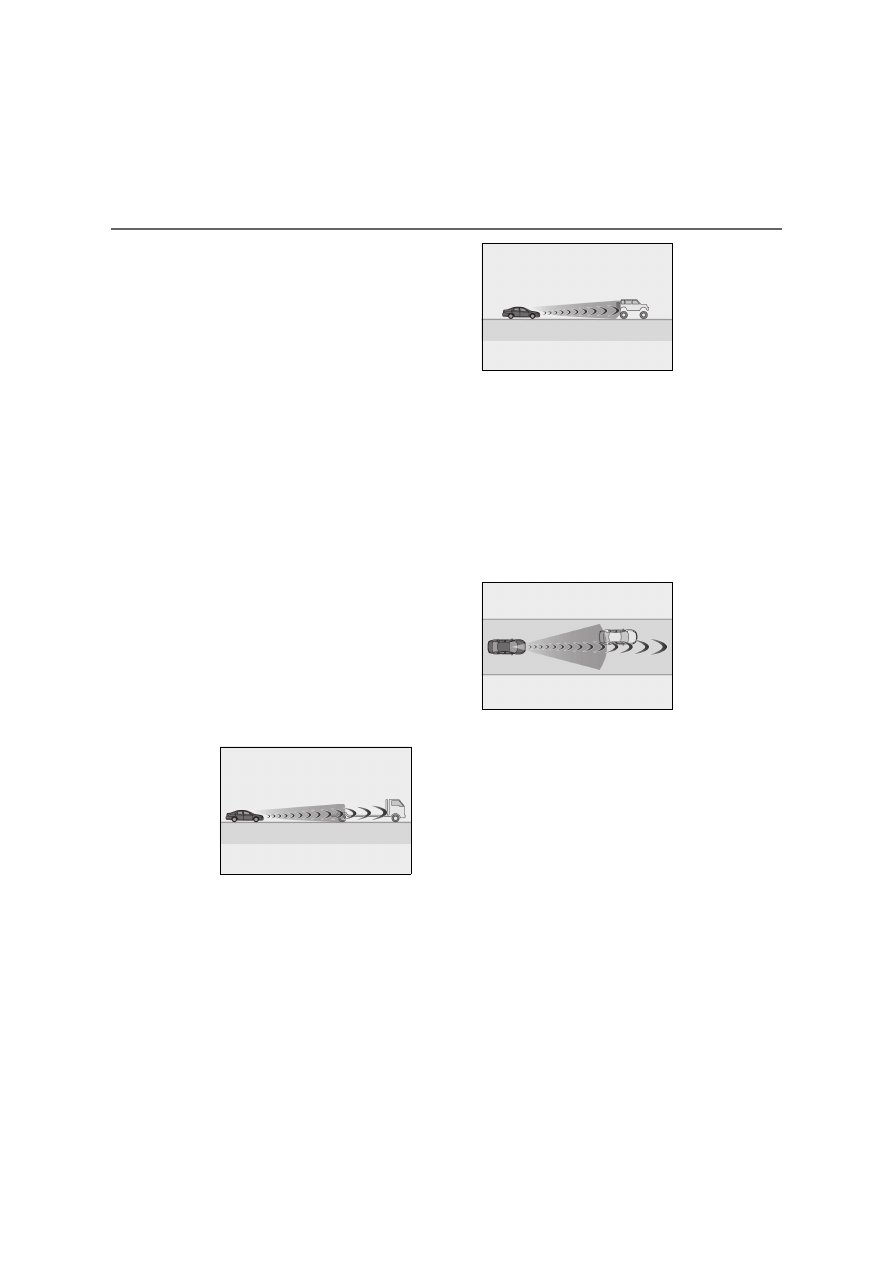
238
4-5. Using the driving support systems
dust, etc. from a vehicle ahead
• When driving through steam or smoke
• When there are patterns or paint on the
road or a wall that may be mistaken for a
vehicle or pedestrian
*2
• When driving near an object that reflects
radio waves, such as a large truck or
guardrail
• When driving near a TV tower, broad-
casting station, electric power plant, or
other location where strong radio waves
or electrical noise may be present
*2
: For countries/areas specified as Region
B (
P.232), the pedestrian detection
function may not be available.
Q
Situations in which the system may not
operate properly
O
In some situations such as the following, a
vehicle may not be detected by the radar
sensor and front camera, preventing the
system from operating properly:
• If an oncoming vehicle is approaching
your vehicle
• If a vehicle ahead is a motorcycle or bicy-
cle
• When approaching the side or front of a
vehicle
• If a preceding vehicle has a small rear
end, such as an unloaded truck
• If a preceding vehicle has a low rear end,
such as a low bed trailer
• If a vehicle ahead is carrying a load which
protrudes past its rear bumper
• If a vehicle ahead has extremely high
ground clearance
• If a vehicle ahead is irregularly shaped,
such as a tractor or side car
• If the sun or other light is shining directly
on a vehicle ahead
• If a vehicle cuts in front of your vehicle or
emerges from beside a vehicle
• If a vehicle ahead makes an abrupt
maneuver (such as sudden swerving,
acceleration or deceleration)
• When suddenly cutting behind a preced-
ing vehicle
• When a vehicle ahead is not directly in
front of your vehicle
• When driving in inclement weather such
as heavy rain, fog, snow or a sandstorm
• When the vehicle is hit by water, snow,
dust, etc. from a vehicle ahead
• When driving through steam or smoke
• When driving in a place where the sur-
rounding brightness changes suddenly,
such as at the entrance or exit of a tunnel
• When a very bright light, such as the sun
or the headlights of oncoming traffic,
shines directly into the front camera
• When the surrounding area is dim, such
as at dawn or dusk, or while at night or in
a tunnel
• After the engine has started the vehicle
has not been driven for a certain amount
of time
• While making a left/right turn and for a
few seconds after making a left/right turn
• While driving on a curve and for a few
seconds after driving on a curve
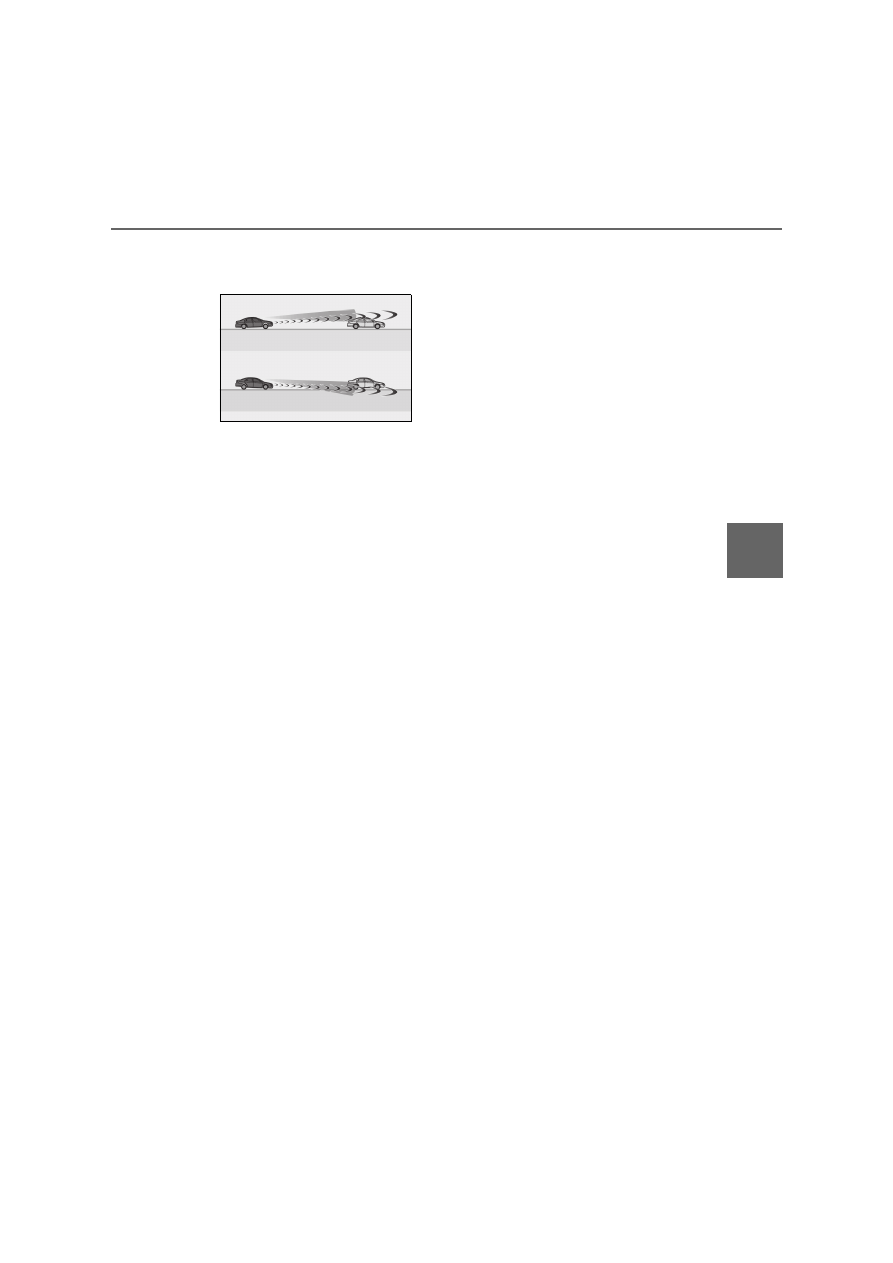
239
4
4-5. Using the driving support systems
Dr
ivin
g
• If your vehicle is skidding
• If the front of the vehicle is raised or low-
ered
• If the wheels are misaligned
• If a wiper blade is blocking the front cam-
era
• The vehicle is wobbling.
• The vehicle is being driven at extremely
high speeds.
• When driving on a hill
• If the radar sensor or front camera is mis-
aligned
O
In some situations such as the following,
sufficient braking force may not be
obtained, preventing the system from
performing properly:
• If the braking functions cannot operate to
their full extent, such as when the brake
parts are extremely cold, extremely hot,
or wet
• If the vehicle is not properly maintained
(brakes or tires are excessively worn,
improper tire inflation pressure, etc.)
• When the vehicle is being driven on a
gravel road or other slippery surface
O
Some pedestrians such as the following
may not be detected by the radar sensor
and front camera, preventing the system
from operating properly
*2
:
• Pedestrians shorter than approximately 1
m (3.2 ft.) or taller than approximately 2
m (6.5 ft.)
• Pedestrians wearing oversized clothing
(a rain coat, long skirt, etc.), making their
silhouette obscure
• Pedestrians who are carrying large bag-
gage, holding an umbrella, etc., hiding
part of their body
• Pedestrians who are bending forward or
squatting
• Pedestrians who are pushing a stroller,
wheelchair, bicycle or other vehicle
• Groups of pedestrians which are close
together
• Pedestrians who are wearing white and
look extremely bright
• Pedestrians in the dark, such as at night
or while in a tunnel
• Pedestrians whose clothing appears to
be nearly the same color or brightness as
their surroundings
• Pedestrians near walls, fences, guard-
rails, or large objects
• Pedestrians who are on a metal object
(manhole cover, steel plate, etc.) on the
road
• Pedestrians who are walking fast
• Pedestrians who are changing speed
abruptly
• Pedestrians running out from behind a
vehicle or a large object
• Pedestrians who are extremely close to
the side of the vehicle (outside rear view
mirror, etc.)
*2
: For countries/areas specified as Region
B (
P.232), the pedestrian detection
function may not be available.
Q
If VSC is disabled
O
If VSC is disabled (
P.292), the pre-
collision brake assist and pre-collision
braking functions are also disabled.
O
The PCS warning light will turn on and
“VSC Turned Off Pre-Collision Brake
System Unavailable” will be displayed on
the multi-information display.
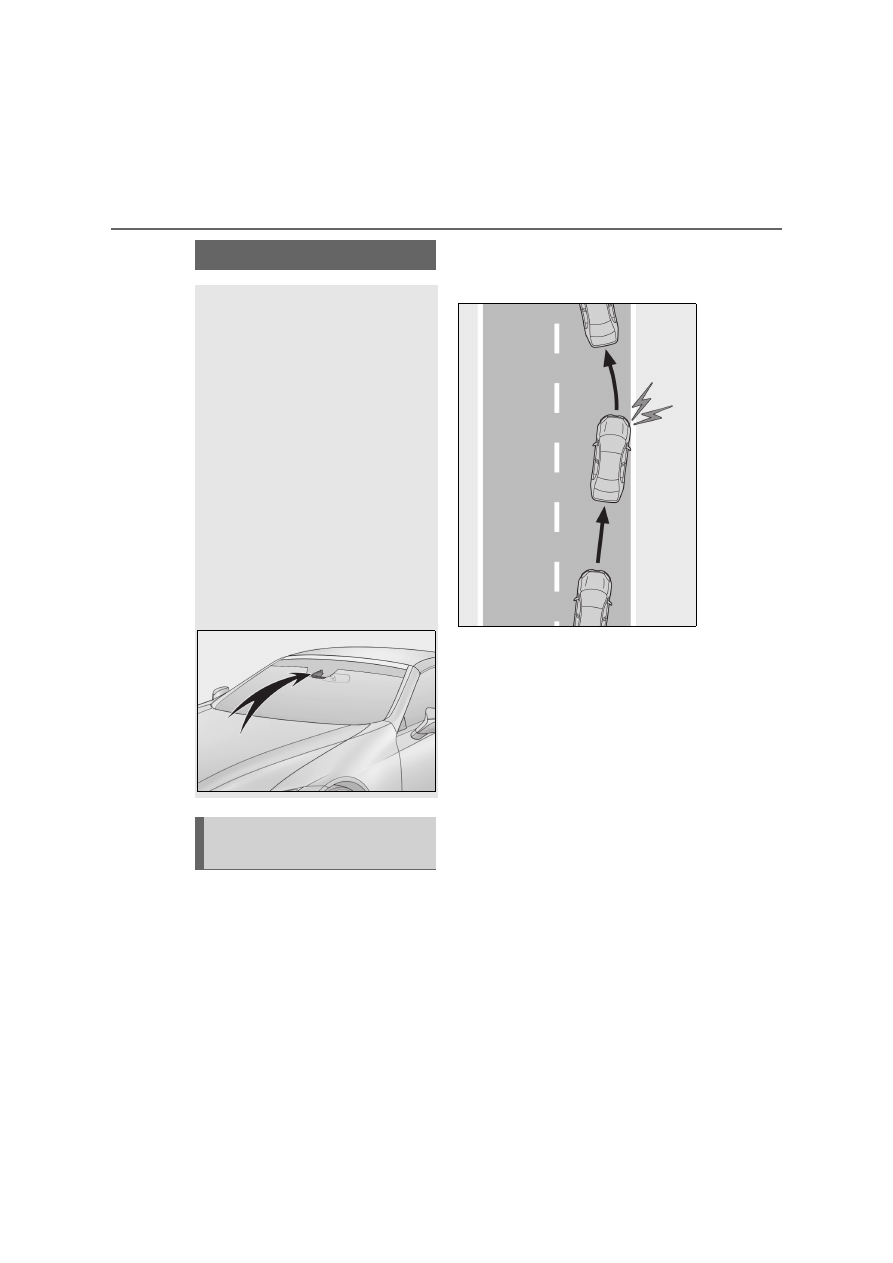
240
4-5. Using the driving support systems
Q
Lane departure alert function
When the system determines that the
vehicle might depart from its lane, a
warning is displayed on the multi-infor-
mation display, and either the warning
buzzer sounds to alert the driver.
When the warning buzzer sounds, check
the surrounding road situation and care-
fully operate the steering wheel to move
the vehicle back to the center of the lane.
Q
Steering assist function
When the system determines that the
vehicle might depart from its lane, the
system provides assistance as neces-
sary by operating the steering wheel in
small amounts for a short period of
time to keep the vehicle in its lane.
If the system detects that the steering
wheel has not been operated for a fixed
amount of time or the steering wheel is not
being firmly gripped, a warning is dis-
played on the multi-information display
and the function is temporarily canceled.
LKA (Lane-Keeping Assist)
When driving on highways and
freeways with white or yellow lines,
this function alerts the driver when
the vehicle might depart from its
lane and provides assistance by
operating the steering wheel to
keep the vehicle in its lane. Further-
more, the system also provides
steering assistance when dynamic
radar cruise control with full-speed
range is operating to keep the vehi-
cle in its lane.
The LKA system recognizes visible
white or yellow lines with the front
camera on the upper portion of the
front windshield.
Functions included in LKA sys-
tem
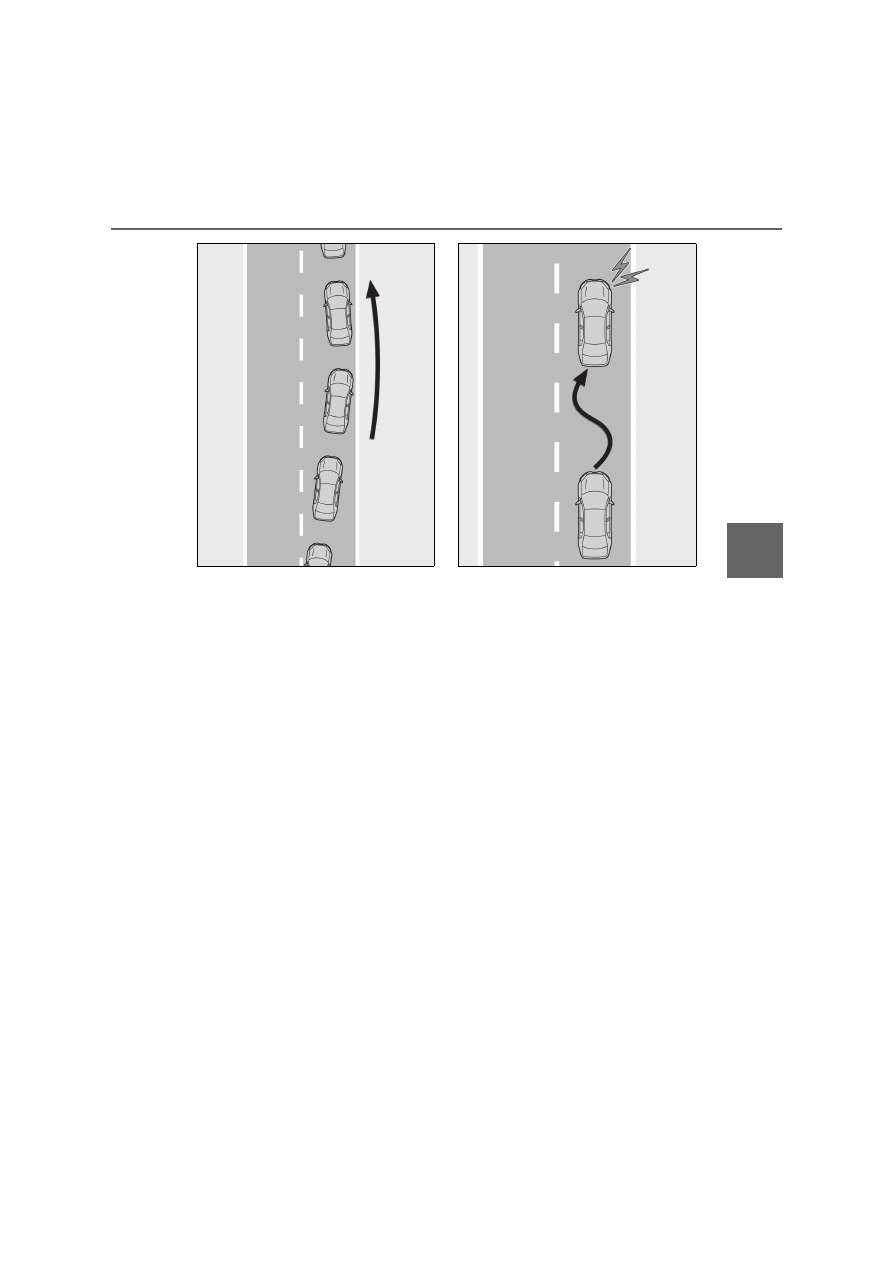
241
4
4-5. Using the driving support systems
Dr
ivin
g
Q
Vehicle sway warning function
When the vehicle is swaying or
appears as if it may depart from its lane
multiple times, the warning buzzer
sounds and a message is displayed on
the multi-information display to alert
the driver.
Q
Lane centering function
This function is linked with radar cruise
control and provides the required
assistance by operating the steering
wheel to keep the vehicle in its current
lane.
When radar cruise control is not operat-
ing, the lane centering function does not
operate.
If the system detects that the steering
wheel has not been operated for a fixed
amount of time or the steering wheel is not
being firmly gripped, a warning is dis-
played on the multi-information display
and the function is temporarily canceled.
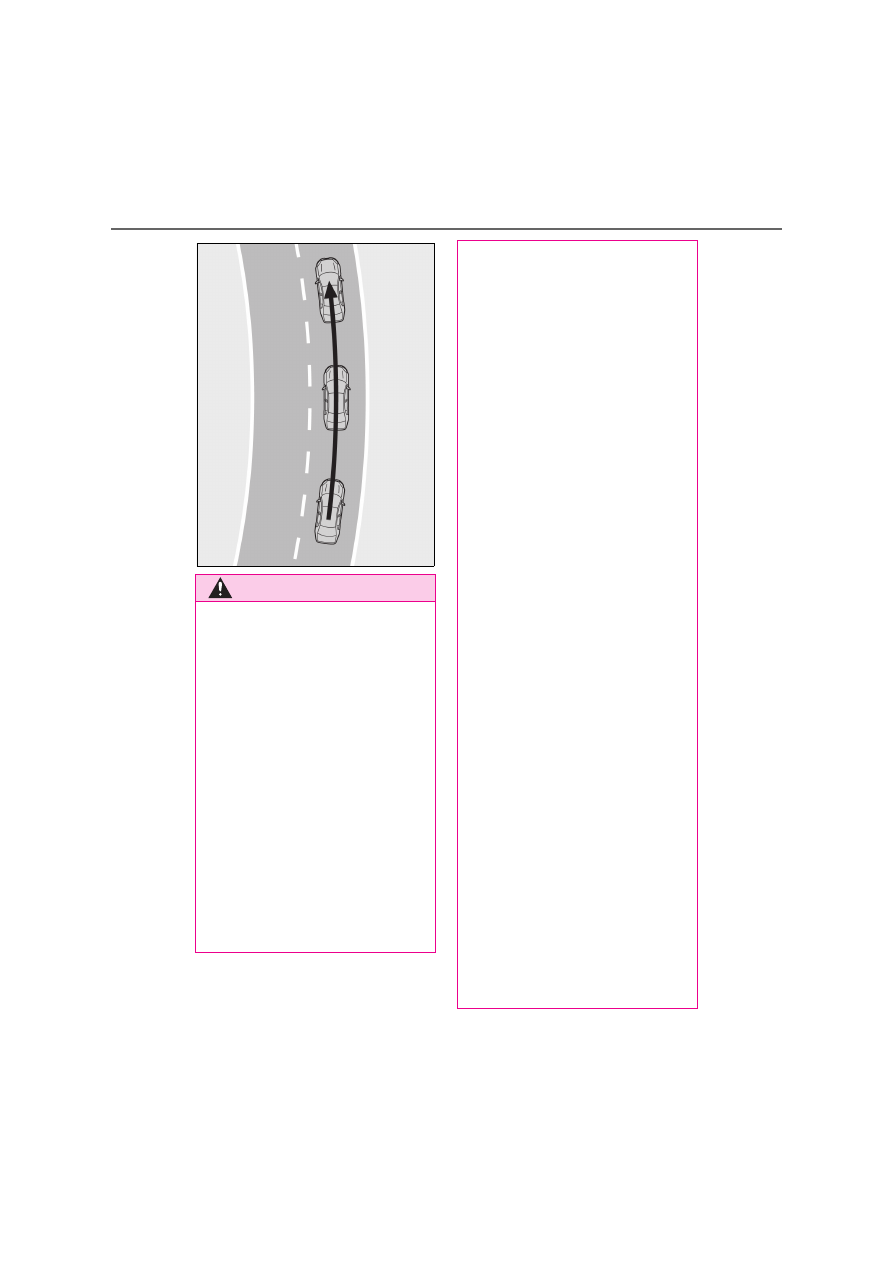
242
4-5. Using the driving support systems
WARNING
Q
Before using LKA system
Do not rely solely upon the LKA system.
The LKA system does not automatically
drive the vehicle or reduce the amount of
attention that must be paid to the area in
front of the vehicle. The driver must
always assume full responsibility for driv-
ing safely by paying careful attention to
the surrounding conditions and operat-
ing the steering wheel to correct the path
of the vehicle. Also, the driver must take
adequate breaks when fatigued, such as
from driving for a long period of time.
Failure to perform appropriate driving
operations and pay careful attention may
lead to an accident, resulting in death or
serious injury.
Q
To avoid operating LKA system by
mistake
When not using the LKA system, use the
LKA switch to turn the system off.
Q
Situations unsuitable for LKA system
Do not use the LKA system in the follow-
ing situations.
The system may not operate properly
and lead to an accident, resulting in
death or serious injury.
O
A spare tire, tire chains, etc. are
equipped.
O
When the tires have been excessively
worn, or when the tire inflation pres-
sure is low.
O
Tires which differ by structure, manu-
facturer, brand or tread pattern are
used.
O
Objects or patterns that could be mis-
taken for white (yellow) lines are pres-
ent on the side of the road (guardrails,
curbs, reflective poles, etc.).
O
Vehicle is driven on a snow-covered
road.
O
White (yellow) lines are difficult to see
due to rain, snow, fog, dust, etc.
O
Asphalt repair marks, white (yellow)
line marks, etc. are present due to road
repair.
O
Vehicle is driven in a temporary lane
or restricted lane due to construction
work.
O
Vehicle is driven on a road surface
which is slippery due to rainy weather,
fallen snow, freezing, etc.
O
Vehicle is driven in traffic lanes other
than on highways and freeways.
O
Vehicle is driven in a construction
zone.
Q
Preventing LKA system malfunctions
and operations performed by mistake
O
Do not modify the headlights or place
stickers, etc. on the surface of the
lights.

Нет комментариевНе стесняйтесь поделиться с нами вашим ценным мнением.
Текст